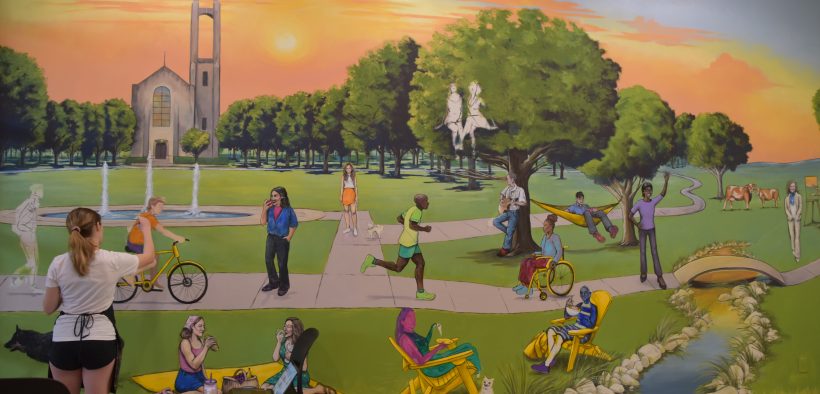New Mural in Comms Sparks Controversy Among Students
Share

With Additional Reporting by Tessa Elizondo
Senior Thira Schlegel was commissioned by President Trombley to paint a mural in the Commons as a part of its larger redesign. The mural is on the wall to your left when standing in line at the entryway. She was told to produce something to “liven up the comms” and to include a couple dairy cows. So Thira used her imagination to produce a welcoming picture of student life and proceeded in painting the mural without any other guidelines.
Thira went to The Art Institute of Chicago for two years before transferring to Southwestern. Upon transferring, she felt welcomed on Southwestern campus and found it to be much more diverse than her previous school. When Kellie Henderson who is the Vice President of Black Student Union (BSU) learned that Thira intended to depict diversity, she said: “Diversity at SU presented by a white woman. Have we not heard their story enough?” Kellie believes that Thira ought to have consulted the Justice-Equity-Diversity-Inclusion Center (JEDI Center) before trying to represent students of color.
In painting the mural, Thira sought to reproduce her own vision of Southwestern. So she painted friends, family, and others who have made an impact on her Southwestern experience. Although some of the people in the mural are people Thira actually knows— most of them are people from stock images. When the mural was near complete most of the subjects, including the generic representations of white students, had been identified as actual people who currently work at or attend SU. However, there was a black girl in a wheelchair and a black male student in the picture who were unidentifiable. The fact that there were no black people, aside from Miss Ella, who are real members of the SU community, sparked outrage among students.
Kellie was upset that there were no black students who actually go to SU depicted. She said: “Of course, Miss Ella is going to be there, she’s a staple for the mural. She has been working here for twenty-four years. She would be depicted no matter what color she was— whether she was black, blue or purple. […] I know it’s a small thing, but it’s only small to the people who aren’t black.”
In an interview, Thira explained that:
“Originally […] I was going to stick with one color so people would be like red, or green, or blue. But after I started to get more personal with the piece, I added skin color and it kind of morphed. Now, I think it’s a good mix of people I know and don’t know. But, at the end of the day, it’s not really about whether I know these people or not. I’ve had people come by and be, like, ‘yeah that looks like my friend!’ and I say it can be if you want it to be”.
Thira included the black girl in the wheelchair and the black man because she believes that by including these figures, it shows that SU is accepting of everybody. She also needed subjects to be in certain poses and using stock images made this easier. In painting the mural, she was aiming to depict an ideal Southwestern campus— one where Miss Ella is as happy as ever, President Trombley is smiling right at you, students are lounging in hammocks, and a black girl is cruising down the sidewalk in her wheelchair. Thira tried to paint Southwestern as a place where any student can come and be accepted. She hopes that students touring SU would look at the mural and feel welcome. However, the mural could be seen as false advertising because there is no Southwestern student who is a black girl in a wheelchair.
Kellie said that she “wouldn’t want a black girl in a wheelchair to see that mural and think that if she went here she would be properly accommodated.” From Kellie’s perspective, SU hasn’t been able to properly accommodate people of color or disabled people. She sees this as evident by SU’s inability to catch the people who have been committing hate crimes. She also has noticed a lack of wheelchair accessibility in certain places on campus. A black girl in a wheelchair isn’t just a woman, or a POC, or disabled person— she is a black disabled woman. There are several different aspects to person’s identity that effects how they may experience discrimination. BSU’s issue with the mural is that it doesn’t accurately represent students of color at Southwestern. A meeting is taking place tomorrow morning (2/23) between the JEDI center, members of BSU and Thira. Next week, The Megaphone will release an update.
